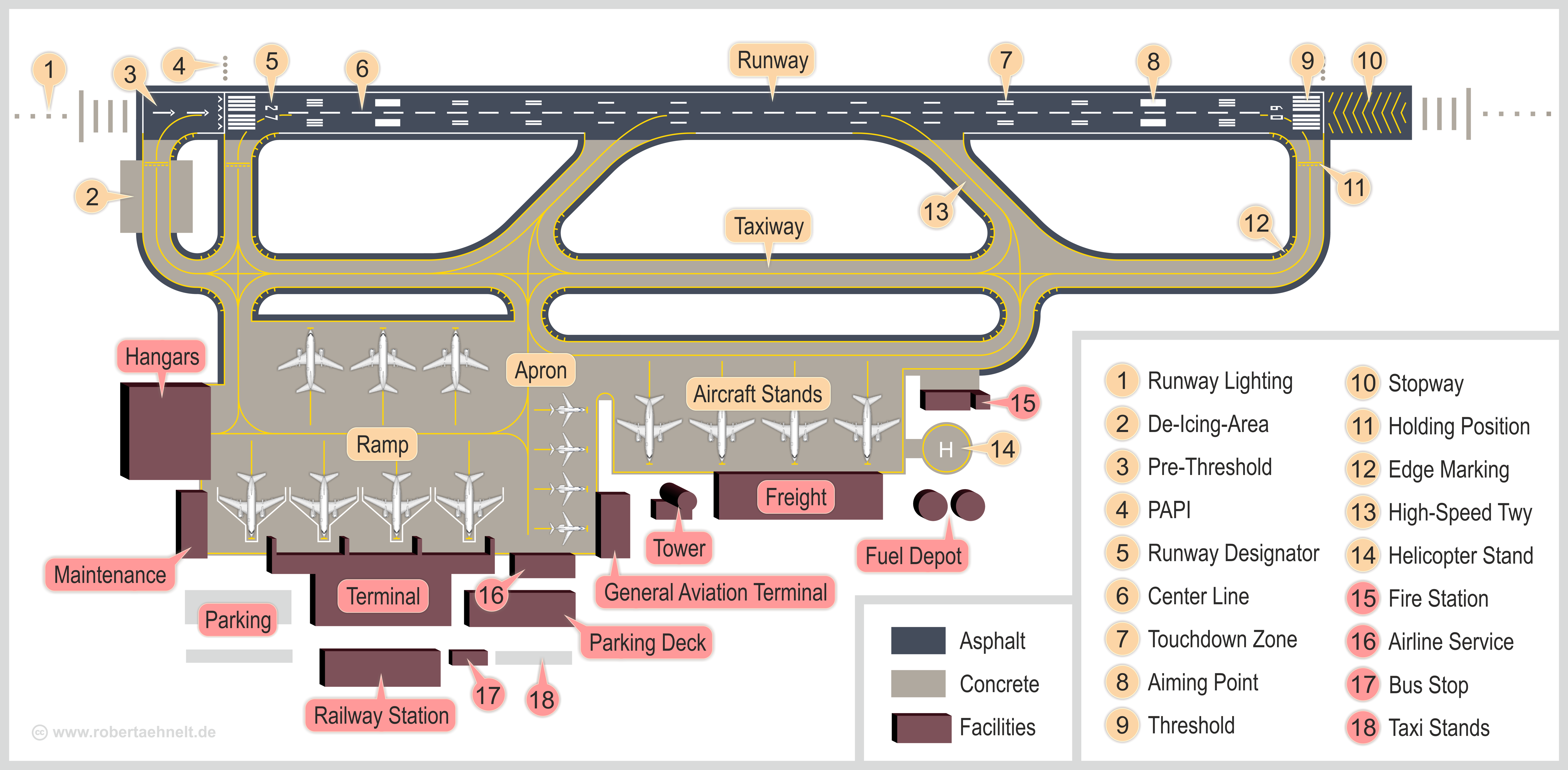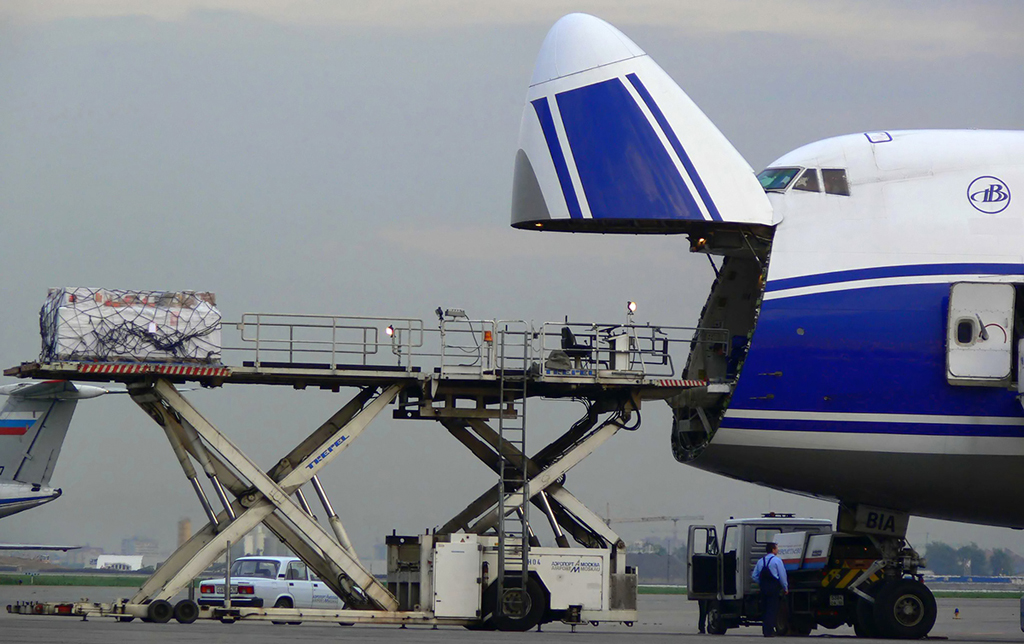|
Backtaxi
Backtaxi (also known as backtrack) is an airport ground procedure which involves the use of any portion of a runway as a taxiway for an aircraft to taxi in the opposite direction from which it will take off or has landed. The procedure is commonly used at smaller airports and private strips which may not have separate paved taxiways parallel to the runway. It is a higher-risk procedure, as pilots may not see, or hear the radio transmissions from, aircraft taxiing on the runway. At controlled airports, take-off or landing clearances do not authorize the pilot to reverse course and backtrack along the runway, unless specified by air traffic control. At uncontrolled airports, pilots are recommended to broadcast their intentions while backtracking in the interest of safety; for example, the statement "Entering and backtracking runway 36" would indicate the aircraft is taxiing along a magnetic heading of 180 degrees, against the flow of traffic. An infamous and rare example of where ba ... [...More Info...] [...Related Items...] OR: [Wikipedia] [Google] [Baidu] |
Tenerife Airport Disaster
The Tenerife airport disaster occurred on March 27, 1977, when two Boeing 747 passenger jets collided on the runway at Los Rodeos Airport (now Tenerife North Airport) on the Spanish island of Tenerife. The collision occurred when KLM Flight 4805 initiated its takeoff run while Pan Am Flight 1736 was still on the runway. The impact and resulting fire killed everyone on board KLM 4805 and most of the occupants of Pan Am 1736, with only 61 survivors in the front section of the aircraft. With 583 fatalities, the disaster is the List of aircraft accidents and incidents resulting in at least 50 fatalities, deadliest accident in aviation history. A bomb set off by the Canary Islands Independence Movement at Gran Canaria Airport had caused many flights to be diverted to Los Rodeos, including the two aircraft involved in the accident. The airport quickly became congested with parked airplanes blocking the only taxiway and forcing departing aircraft to taxi on the runway instead. Patche ... [...More Info...] [...Related Items...] OR: [Wikipedia] [Google] [Baidu] |
Airport
An airport is an aerodrome with extended facilities, mostly for commercial air transport. Airports usually consists of a landing area, which comprises an aerially accessible open space including at least one operationally active surface such as a runway for a plane to take off and to land or a helipad, and often includes adjacent utility buildings such as control towers, hangars and terminals, to maintain and monitor aircraft. Larger airports may have airport aprons, taxiway bridges, air traffic control centres, passenger facilities such as restaurants and lounges, and emergency services. In some countries, the US in particular, airports also typically have one or more fixed-base operators, serving general aviation. Operating airports is extremely complicated, with a complex system of aircraft support services, passenger services, and aircraft control services contained within the operation. Thus airports can be major employers, as well as important hubs for tou ... [...More Info...] [...Related Items...] OR: [Wikipedia] [Google] [Baidu] |
Runway
According to the International Civil Aviation Organization (ICAO), a runway is a "defined rectangular area on a land aerodrome prepared for the landing and takeoff of aircraft". Runways may be a man-made surface (often asphalt concrete, asphalt, concrete, or a mixture of both) or a natural surface (sod, grass, soil, dirt, gravel, ice, sand or road salt, salt). Runways, as well as taxiways and Airport apron, ramps, are sometimes referred to as "tarmac", though very few runways are built using Tarmacadam, tarmac. Takeoff and landing areas defined on the surface of water for seaplanes are generally referred to as waterways. Runway lengths are now International Civil Aviation Organization#Use of the International System of Units, commonly given in meters worldwide, except in North America where feet are commonly used. History In 1916, in a World War I war effort context, the first concrete-paved runway was built in Clermont-Ferrand in France, allowing local company Michelin to ... [...More Info...] [...Related Items...] OR: [Wikipedia] [Google] [Baidu] |
Taxiway
A taxiway is a path for aircraft at an airport connecting runways with aprons, hangars, terminals and other facilities. They mostly have a hard surface such as asphalt or concrete, although smaller general aviation airports sometimes use gravel or grass. Most airports do not have a specific speed limit for taxiing (though some do). There is a general rule on safe speed based on obstacles. Operators and aircraft manufacturers might have limits. Typical taxi speeds are 20–30 knots (37–56 km/h; 23–35 mph). High-speed exit Busy airports typically construct high-speed or rapid-exit taxiways to allow aircraft to leave the runway at higher speeds. This allows the aircraft to vacate the runway quicker, permitting another to land or take off in a shorter interval of time. This is accomplished by reducing the angle the exiting taxiway intercepts the runway at to 30 degrees, instead of 90 degrees, thus increasing the speed at which the aircraft can exit the runway onto the taxiway ... [...More Info...] [...Related Items...] OR: [Wikipedia] [Google] [Baidu] |
Taxiing
Taxiing (rarely spelled taxying) is the movement of an aircraft on the ground, under its own power, in contrast to towing or pushback where the aircraft is moved by a tug. The aircraft usually moves on wheels, but the term also includes aircraft with skis or floats (for water-based travel). An airplane uses taxiways to taxi from one place on an airport to another; for example, when moving from a hangar to the runway. The term "taxiing" is not used for the accelerating run along a runway prior to takeoff, or the decelerating run immediately after landing, which are called the takeoff roll and landing rollout, respectively. Etymology As early as 1909 aviation journalists envisioned aeroplanes to replace the taxicab in traffic-congested cities. Some aviators and some linguists report that around the year 1911 the slang word "taxi" was in use for an "airplane". They suggest that the way aircraft move under power before they take off or after they land reminded someone ... [...More Info...] [...Related Items...] OR: [Wikipedia] [Google] [Baidu] |
Federal Aviation Administration
The Federal Aviation Administration (FAA) is the largest transportation agency of the U.S. government and regulates all aspects of civil aviation in the country as well as over surrounding international waters. Its powers include air traffic management, certification of personnel and aircraft, setting standards for airports, and protection of U.S. assets during the launch or re-entry of commercial space vehicles. Powers over neighboring international waters were delegated to the FAA by authority of the International Civil Aviation Organization. Created in , the FAA replaced the former Civil Aeronautics Board, Civil Aeronautics Administration (CAA) and later became an agency within the United States Department of Transportation, U.S. Department of Transportation. Major functions The FAA's roles include: *Regulating U.S. commercial space transportation *Regulating air navigation facilities' geometric and flight inspection standards *Encouraging and developing civil aeronautics, ... [...More Info...] [...Related Items...] OR: [Wikipedia] [Google] [Baidu] |
United States House Committee On Transportation And Infrastructure
The U.S. House Committee on Transportation and Infrastructure is a standing committee of the United States House of Representatives. History The Committee on Transportation and Infrastructure was formerly known as the Committee on Public Works and Transportation from 1975 to 1994, and the Committee on Public Works between 1947 and 1974. Under the Legislative Reorganization Act of 1946 the Committees on Public Buildings and Grounds (1837–1946), Rivers and Harbors (1883–1946), Roads (1913–46), and the Flood Control (1916–46) were combined to form the Committee on Public Works. Its jurisdiction from the beginning of the 80th Congress (1947–48) through the 90th Congress (1967–68) remained unchanged. [...More Info...] [...Related Items...] OR: [Wikipedia] [Google] [Baidu] |
Boeing 747
The Boeing 747 is a large, long-range wide-body airliner designed and manufactured by Boeing Commercial Airplanes in the United States between 1968 and 2022. After introducing the 707 in October 1958, Pan Am wanted a jet times its size, to reduce its seat cost by 30%. In 1965, Joe Sutter left the 737 development program to design the 747, the first twin-aisle airliner. In April 1966, Pan Am ordered 25 Boeing 747-100 aircraft and in late 1966, Pratt & Whitney agreed to develop the JT9D engine, a high-bypass turbofan. On September 30, 1968, the first 747 was rolled out of the custom-built Everett Plant, the world's largest building by volume. The first flight took place on February 9, 1969, and the 747 was certified in December of that year. It entered service with Pan Am on January 22, 1970. The 747 was the first airplane dubbed "Jumbo Jet", the first wide-body airliner. The 747 is a four-engined jet aircraft, initially powered by Pratt & Whitney JT9D turbof ... [...More Info...] [...Related Items...] OR: [Wikipedia] [Google] [Baidu] |
Tenerife North Airport
Tenerife (; ; formerly spelled ''Teneriffe'') is the largest and most populous island of the Canary Islands. It is home to 43% of the total population of the Archipelago, archipelago. With a land area of and a population of 978,100 inhabitants as of January 2022, it is also the most populous island of Spain and of Macaronesia. Approximately five million tourists visit Tenerife each year; it is the most visited island in the archipelago. It is one of the most important tourist destinations in Spain and the world, hosting one of the world's largest carnivals, the Carnival of Santa Cruz de Tenerife. The capital of the island, , is also the seat of the island council (). That city and are the co-capitals of the autonomous community of the Canary Islands. The two cities are both home to governmental institutions, such as the offices of the presidency and the ministries. This has been the arrangement since 1927, when the Crown ordered it. (After the 1833 territorial division of Sp ... [...More Info...] [...Related Items...] OR: [Wikipedia] [Google] [Baidu] |
The Daily Telegraph
''The Daily Telegraph'', known online and elsewhere as ''The Telegraph'', is a national British daily broadsheet newspaper published in London by Telegraph Media Group and distributed across the United Kingdom and internationally. It was founded by Arthur B. Sleigh in 1855 as ''The Daily Telegraph & Courier''. Considered a newspaper of record over ''The Times'' in the UK in the years up to 1997, ''The Telegraph'' generally has a reputation for high-quality journalism, and has been described as being "one of the world's great titles". The paper's motto, "Was, is, and will be", appears in the editorial pages and has featured in every edition of the newspaper since 19 April 1858. The paper had a circulation of 363,183 in December 2018, descending further until it withdrew from newspaper circulation audits in 2019, having declined almost 80%, from 1.4 million in 1980.United Newspapers PLC and Fleet Holdings PLC', Monopolies and Mergers Commission (1985), pp. 5–16. Its ... [...More Info...] [...Related Items...] OR: [Wikipedia] [Google] [Baidu] |
Elsevier Science
Elsevier () is a Dutch academic publishing company specializing in scientific, technical, and medical content. Its products include journals such as ''The Lancet'', '' Cell'', the ScienceDirect collection of electronic journals, '' Trends'', the '' Current Opinion'' series, the online citation database Scopus, the SciVal tool for measuring research performance, the ClinicalKey search engine for clinicians, and the ClinicalPath evidence-based cancer care service. Elsevier's products and services also include digital tools for data management, instruction, research analytics and assessment. Elsevier is part of the RELX Group (known until 2015 as Reed Elsevier), a publicly traded company. According to RELX reports, in 2021 Elsevier published more than 600,000 articles annually in over 2,700 journals; as of 2018 its archives contained over 17 million documents and 40,000 e-books, with over one billion annual downloads. Researchers have criticized Elsevier for its high profit margi ... [...More Info...] [...Related Items...] OR: [Wikipedia] [Google] [Baidu] |







